Please Take Note: This is a review of the final game, but it might change slightly based on the success of the Kickstarter campaign. The game is being reviewed on the components and the rules provided with the understanding that “what you see is not what you might get” when the game is published. If you like what you read and want to learn more, we encourage you to visit the game publisher’s website or visit the Kickstarter campaign. Now that we have all that disclaimer junk out of the way, on with the review.
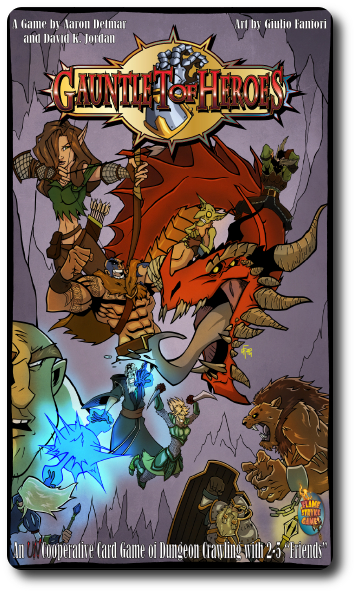
The Basics:
- For ages 7 and up (publisher suggests 13+)
- For 2 to 5 players
- Approximately 60 minutes to complete
Geek Skills:
- Active Listening & Communication
- Counting & Math
- Logical & Critical Decision Making
- Reading
- Risk vs. Reward
- Hand/Resource Management
Learning Curve:
- Child – Easy
- Adult – Easy
Theme & Narrative:
- Grab your team of adventurers and explore the depths of a dangerous Crypt
Endorsements:
- Gamer Geek rejected!
- Parent Geek approved!
- Child Geek approved!
Overview
It all started with a boast that one group of adventurers sitting at a table was better than another group of adventurers sitting at a table a few feet away. Words were exchanged, followed by fists. When the smashed tables were cleared and everyone calmed down, the adventurers decided that the best way to prove which group was better was to raid one of the most dangerous Crypts in the area. Dangerous and potentially highly profitable! The team that survived the Crypt with the most gold would win. This sounded great to the inn keeper because someone was going to have to pay him for the damages.
Gauntlet of Heroes, designed by Aaron Detmar, David K. Jordan, and to be published by FlameStryke Games, will reportedly be comprised of 32 Hero cards, 46 Challenge cards, 8 Elite cards, 46 Treasure cards, 86 Battle cards, 5 Resting cards, 1 Quick Reference card, and 2 standard six-sided dice. As this is a review of a prepublished game, I will not comment on the game’s component quality. The illustrations by Giulio Fanfori are excellent, depicting treasure to hoard, monsters to fight, and heroes to cheer for.
Note: Some of the Parent Geeks found a few of the illustrations on the cards to be a bit too titillating to put in front of the Child Geeks. I personally had no issues with what was provided, but I understand the dilemma. Scantily clad female elves are hard to look away from and uncomfortable to talk about in front of curious kiddos. The solution was to remove these few cards, which resulted in no negative impact to the game or the game play. As always, Parent Geeks should familiarize themselves with games, movies, books, television, music, clothes, and just about everything else before putting it in front of their Child Geeks. Or forget about all that and simply do it. As parents, we learn as we go.
Preparing the Gauntlet
To set up the game, separate the Hero, Challenge, Elite, Treasure, and Battle cards into their own decks. Give each deck a shuffle and place face-down.
Second, take the Treasure deck and deal 2 Treasure cards face-down on top of each other. Below that, deal a row of 2 Treasure cards. Below these 2 Treasure cards, deal 3 more Treasure cards in a row. Finally, deal another row of 4 Treasure cards. The end result should be a pyramid formation in the middle of the playing area that is referred to as the “Crypt”. Each Treasure card represents 1 room in the Crypt the players’ heroes will be exploring. Place the Treasure deck to one side of the game playing area.
Third, take the Elite deck and deal 1 Elite card face-down on top of the 2 Treasure cards at the top of the pyramid formation. Place the Elite deck to one side of the game playing area.
Fourth, take the Challenge deck and deal 1 Challenge card face-down on each of the 3 rows of Treasure cards below the Elite card. Place the Challenge deck to one side of the game playing area. The Crypt is now set, complete with treasures and challenges. The final set up of the Crypt should look something similar to the following image.
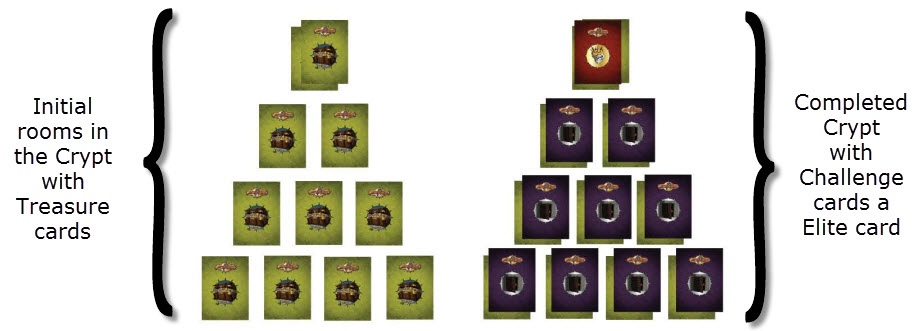
Fifth, take the Hero deck and deal 3 Hero cards to each player. The Hero cards are placed face-up in front of their owning player. Players should leave room for a Victory pile where they will place Challenge cards they have defeated during the game. Place the Hero deck to one side of the game playing area.
Sixth, take the Battle deck and deal to each player a number of Battle cards equal to the number of players in the game. These cards are collected by the player and kept as their starting hand. Players should not reveal the cards in their hand until they are played. Place the Battle deck to one side of the game playing area.
Seventh, take the Treasure deck and deal 3 Treasure cards to each player. These Treasure cards are taken into the player’s hand along with the Battle cards. Place the Treasure deck to one side of the game playing area.
Eighth, grab the six-sided dice and determine who is the first player.
That’s it for game set up. Time to run the gauntlet.
Proper Care and Leading of Heroes
Before a player jumps into the Crypt leading their band of heroes to certain danger, it’s important to understand the basics.
Treasure
Let’s cut to the chase. The only reasons the heroes would enter the foreboding Crypt is because of the treasure it contains. The promise of unimaginable wealth has a way of making a rational mind forget all about danger and venture forth into places purposely designed to destroy would-be trespassers. Within the Crypt are Treasure cards. Each will provide points at the end of the game, but they can also be used by the heroes.
Each Treasure card is a handy piece of equipment, augmenting a hero’s natural attributes. The types of equipment found range from the truly miraculous to the utterly bizarre. It’ll be up to the player to determine if a Treasure card should be used for points or for battle.
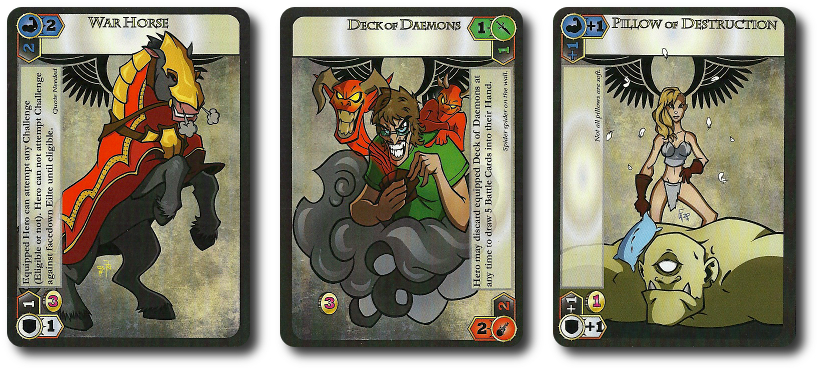
A Hero’s Resume
Every hero and monster has 1 or more attributes. These attributes define the strengths and weaknesses of living creatures and the specific areas that will be tested. If a hero or monster doesn’t have an attribute, it means that the specific characteristics associated with the attribute are not available. If an attribute is not listed, it cannot be used in battle. If the attribute is listed on both the attacker and the defender (the Hero card and the Challenge card), it can be used in battle. In which case, the number values for the attributes are added to the dice rolls. Each attribute is summarized here.
- Might: This attribute measures brute strength, an attribute favored by those who use brawn over brains. Warriors tend to obsesses and focus the most on this attribute.
- Guile: This attribute measures cunning and stealth, an attributed favored by those who prefer stabbing their enemies in the back. It should come as no surprised that rogues spend a great deal of their time honing this particular attribute.
- Magic: This attribute measures magical ability, be it learned or a natural talent based on the hero’s race. Only those who practice magic, such as wizards, mages, and witches, focus on this attribute.
- Faith: This attribute measures the strength of inner belief of the currently popular set of deities that might or might not exist or even care about the mortal realm. Only those heroes who have fully embraced the laws of their belief tend to rely on them blindly during battle.
Injury and Death
The life of a hero is certainly exciting, but it’s also dangerous. The current health of a Hero card is tracked by rotating it. When the Hero card is healthy, it’s rotated upright. When the Hero card is injured, it’s rotated to its side. Heroes can be rotated from injured to healthy during a player’s turn. If, however, a player’s injured Hero loses a battle, the hero perishes. When a Hero card is slain in battle, 1 Treasure card that is equipped on the Hero card is given to the Challenge card. Any remaining equipped Treasure cards and the Hero card are then discarded.
A hero’s effectiveness is also based on its current state of health. Healthy heroes have different attribute values than injured heroes. The numbers for each attribute changes when the card is rotated, making tasks more difficult until the hero is healed. Some heroes gain special abilities when they are injured, giving the player an insensitive to keep some of their heroes dangerously close to Death’s door so they gain an advantage. Some Treasure cards, if used as equipment, can also provide special abilities when the hero is injured, making it all the more desirable at times to risk it all to gain a bonus.
So as to reduce any confusion about what values to read, the game designers purposely made certain that the correct number values to use are always facing upright from the player’s seated vantage point.
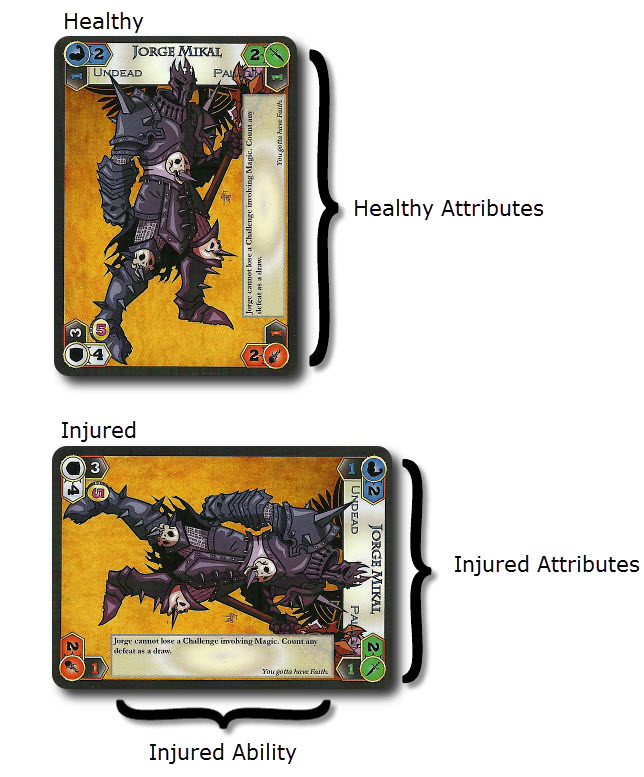
Equipping
A player can equip up to 4 Treasure cards on each of their Hero cards. Doing so automatically forfeits the use of the Treasure card for points, but the benefits frequently outweigh any loses. Each of the hero’s 4 attributes can be augmented by 1 Treasure card no more than twice. These Treasure cards add their value to whatever attribute value they are attached to. If a Treasure card provides more than 1 attribute bonus, the player must select which one they want to use.
When equipping the Treasure card, it’s placed so it’s below the Hero card and adjacent to the attributes it’s augmenting. If a Hero card is fully equipped, it will have much higher attribute values when they are healthy and injured, as equipped Treasure cards rotate with the Hero card when their state of health changes during the game.
Players can upgrade equipment by replacing older Treasure cards with new Treasure cards. The Treasure card being replaced is discarded instead of being sent to the player’s Victory pile.
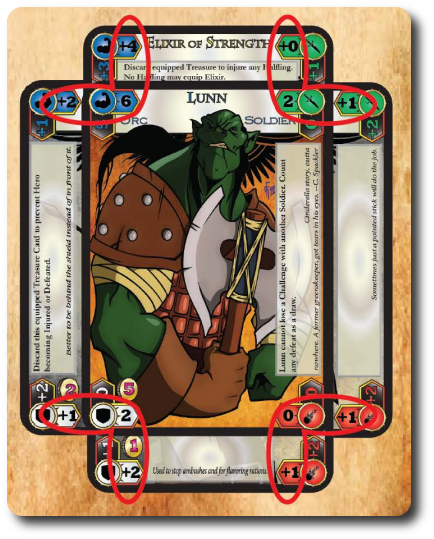
Players should keep in mind at all times that enemies in the Crypt can equip Treasure cards, too. That’s a bit creepy, isn’t it?
A Crypt Full of Challenges
The Crypt is a dangerous place, full of many nasty things that are hungry and grumpy. The only reason any individual would go near the place is because of the treasure that is rumored to be found within it. Stopping the players from rushing in and grabbing all the loot are the many challenges that stand between them and being insanely rich. On top of each Treasure card is a Challenge card, which represents random enemies, events, traps, and obstacles. Let’s look at a few.
This is an enemy Challenge card. The grumpy dwarf archer has its own attributes for combat and can make use of Treasure cards. For example, all enemy Challenge cards have a habit of equipping Treasure cards from fallen and injured heroes whenever possible. When players encounter an enemy in the Crypt, a fight is pretty much guaranteed.
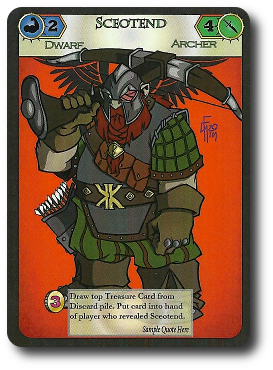
This is an event Challenge card. Unlike encounters with enemies, these types of Challenge cards involve all the players. Sometimes the players are asked to sacrifice cards in hopes of gaining an upper hand or providing something of value.
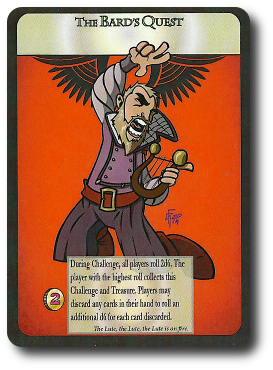
This is trap Challenge card. They are nasty. Sometimes they can be avoided and sometimes effects of the trap cannot be avoided, as is the case with the “Falling Boulder” Challenge card. Long story short, heroes need to make certain they are healthy and prepared for whatever dangers lurk in the dark Crypt.

With over 40 Challenge cards in the game, each Crypt is guaranteed to introduce something new to kill the heroes. There are even Challenge cards that summon Elite cards!
A Hero’s Trial
Gauntlet of Heroes is played in turns with no set number of turns per game. A player’s turn is summarized here. When the term “active player” is used, it’s referring to the player who is currently taking their turn.
Phase 1: Prepare Your Heroes
Each player starts with 3 Hero cards. Using these heroes, the player will be exploring the Crypt, looking for treasure, and fighting monsters. During this phase, the player can either play a Treasure card from their hand and equip it to one of their Hero cards or they can heal an injured hero, rotating the Hero card from “injured” to “healthy”. Heroes who are resting can be equipped or healed, as well.
Phase 2: Explore the Crypt
The player now selects an eligible room in the Crypt to explore. Players always explore the Crypt starting at the base of the pyramid and work their way up to the very top. As such, only the bottom most cards are eligible at this time. This includes all the cards on the bottom-most row and any cards in the row above it that are open due to lower cards not getting in the way. Players can take their heroes into rooms of the Crypt that their opponents were previously in. Any Treasure cards that remain in the room will go to the player who clears the Challenge card.
The following image shows a Crypt currently in the process of being explored. All the cards with a green check mark are eligible to enter. Note that the cards on the furthest right in the row of 3 cards is also eligible because there are no cards directly below it.
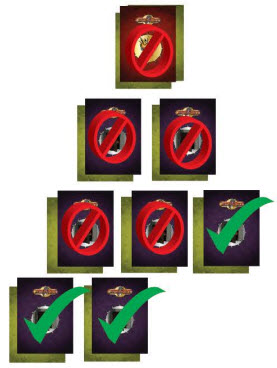
After the room is selected, the player decide which of their heroes will enter the room. This is done BEFORE the Challenge card is revealed. Any Hero card that has the Resting card on top of it cannot be selected. The Challenge card for that room is then placed face-up. Once the Challenge card is revealed, the player needs to decide how best to overcome and defeat whatever challenge was revealed. This is done by selecting an attribute that is listed on both the Hero and the revealed Challenge card. A player cannot select an attribute that is not listed on the Challenge card. If the Challenge card is a trap or some other obstacle, an attribute might not be used. In which case, simply resolve the effects of the Challenge card.
After the hero and the attribute to be used have been selected (where applicable), remove any Resting cards currently on a Hero card owned by the player.
Note: In the event that the only Hero card the player has left is currently resting, they can ignore the effects of the Resting card. This means the player will always be able to explore rooms when only left with 1 Hero card, as long as they keep the Hero healthy.
Phase 3: BATTLE!
In turn order sequence starting with the opponent to the left of the active player, each player now plays 1 Battle card. This phase takes place even if the Challenge card is something as simple as a pit or a cloud of stinky vapor. Players are not required to play a Battle card if they don’t want to. A Battle card can improve the odds of the hero surviving the challenge or greatly reduce them. Battle cards even provide effects that have nothing to do with the battle, allowing players to get more cards. It might also be to an opponent’s advantage to help another player clear a room so they can get to the top of the pyramid faster or maybe they want to do all they can to slow their opponents down.
After all the players have had a chance to play 1 Battle card, ending with the active player, it’s time to see how easy or hard this challenge is going to be. All Battle cards are resolved now, during battle, or after depending on what the Battle card says.
Phase 4: Roll Them Bones
If the Challenge is an enemy, the dice are now used to determine the outcome of the battle. The active player rolls the 2 six-sided dice and announces the rolled result for the hero’s attack after adding the number values of their attribute and equipment being used. The opponent to the active player’s left then rolls the 2 six-sided dice and announces the rolled result for the enemy’s (or trap) attack after adding the number value of the attribute being used, along with any equipment.
- If the hero’s attack value is GREATER than the enemy’s, the hero wins. The Challenge card goes to the active player’s Victory pile, along with the Treasure card. Optionally, the player can take the Treasure card won and immediately equip it to their Hero card. Only 1 Treasure earned from a Challenge can be equipped to the Hero card during a turn. This includes combat against an Elite.
- If the enemy’s attack value is GREATER than the hero’s, the hero is defeated. The Hero card is rotated to show it’s injured (if the hero is already injured, the hero dies), and 1 Treasure card is taken from the Hero card and equipped by the Challenged card if possible. If not, it’s placed underneath the Challenge card. If the hero dies as a result of a failed attack, a Treasure card is still given to the Challenge card and then the Hero card and any remaining Treasure cards still equipped are discarded.
- If the attack values of the hero and the enemy are equal, combat is a draw and the turn continues to the next phase.
Of course, “attack” might not be the correct term to describe the action being played out with the cards. Heroes do have to jump over pits, swing on vines, duck fire jets, and pass other ordeals. No matter what the challenge might be, the method to resolve this step is the same. Roll the dice to determine the outcome.
Phase 5: Resolution
First, gather any successfully defeated Challenge cards and won Treasure cards, placing them in the Victory pile if that has not been done already. Slain Hero cards and any equipped Treasure cards that might still be attached are discarded.
Now the player determines how taxing the last challenge was for their hero. One six-sided die is rolled. On a roll of “6”, the hero wasn’t even winded and can be used during the player’s next turn. On a roll of “1-5”, the hero could use a breather. The Resting card is placed on the Hero card, signifying this particular hero cannot be used on the player’s next turn. The one exception is if the player only has 1 Hero card left. In which case, skip the roll to determine if the Resting card should be placed.
The player is then allowed to discard 1 Battle card from their hand if they want. Then the player draws enough Battle cards to bring their Battle card hand size back to its original amount when the game first began. The important point to make here is that players will be playing Battle cards out of turn during the game. They don’t get to refill their hand until the very end of their turn.
This completes the player’s turn. The next player in turn order sequence now goes starting with phase 1 noted above.
The Final Challenge
At the very top of the pyramid (or the very lowest level of the Crypt, depending on how you want to think about it), is the Elite “Boss” monster. Underneath it are 2 Treasure cards to be won, but the players will have to defeat the Elite card before they can claim them. Unlike the other Challenge cards, the Elite cards are all monsters who are ready to kick some hero butt. Combat against an Elite is more or less the same with a few exceptions which are summarized here.
- When the Elite card is revealed, a Treasure card is drawn and automatically equipped to the Elite card.
- Elite cards do not die if they lose the first battle. Instead, they are rotated and go from healthy to injured, just like a Hero card.
- If the Elite is injured, 1 equipped Treasure card is given to the player to automatically equip to their Hero card or placed in their Victory pile.
- If the Elite dies, 1 equipped Treasure card is given to the player to automatically equip to their Hero or placed in their Victory pile. All other remaining Treasure cards, including those in the room, go to the player’s Victory pile.
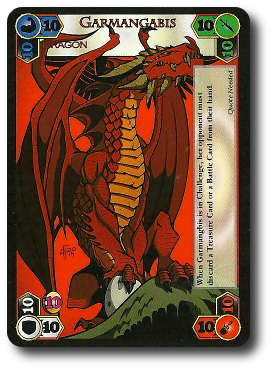
Conquering the Dungeon
When the final Elite card has been defeated, the game comes to an end. Every player now counts the total Gold value found on all their Treasure cards, Elite cards, surviving Hero cards, and Challenge cards, both in their Victory pile and in play. The player with the most Gold has the largest haul of treasure and wins the game. Ties are broken by counting surviving heroes.
Now go pay the inn keeper for the damages caused to his inn…
Game Variants
There are several game variants available that can be used to create more difficult and deadly crypts. Each are summarized here.
Monster Party
The standard game makes use of only 1 Elite card. Use this game variant to introduce 2 or more, depending on what kind of challenge you are looking for. For every Elite card used, make sure to include an additional Treasure card in the room where it’s located. More risk means more reward.
Bigger Crypts
The initial game setup only includes 4 rows of card. If a larger Crypt (and longer game) is desired, add more rows, where each row of cards is 1 more card in total length than the one above it.
Pyramids Were So Last Week
If the pyramid formation isn’t working for you, try other formations. A “diamond” shape is recommended in the rule book, which works pretty well. We suggest a “square” shape, as it’s easy to see which rooms are free to explore and which are still unavailable.
Bank It or Equip It
The standard game has the players count the Gold values for all Treasure cards in the Victory pile and those equipped on Hero cards. This game variant challenges the player to weigh the pros and cons of each Treasure card’s Gold value versus usefulness in the Crypt. Any Treasure cards used as equipment are NOT counted at the end of the game for their Gold value. This game variant was very much enjoyed by our Gamer Geeks and despised by our Child Geeks.
House Rules
Battle Bonus
For younger players or inexperienced players, we found that providing a few more Battle cards up front helped them get going. Deal each player a number of Battle cards equal to the number of players in the game, plus 2 more. The player is given these extra cards to use, but their hand size is not refilled to the starting hand size. As the game progresses, the total number of Battle cards they will be able to draw back up to will be equal to the number of players in the game. Until then, the extra Battle cards should help the new and inexperienced heroes survive long enough to learn and enjoy the game.
Solo Dungeon
My 10-year-old was getting tired of waiting for others to play the game with, so he decided to try the Crypt himself. Set up for a single-player game is the same as a standard game, but changes slightly for the Battle cards. The total number of Battle cards a player can have is equal to the number of players. Since there is only 1 player, the default would be 1 Battle card. The player can increase their total number of Battle cards in their hand, but doing so also increases the total number of Battle cards that will be drawn by the “virtual players” when attempting to tackle a Challenge card. Therefore, the player must balance the size of their hand with the probability of being hit hard by random Battle cards. During challenges, the player draws 1 Battle card against them per Battle card they have in their hand. This mimics the “virtual players”. The player wins if they defeat the final Elite. Subsequent games are all about gathering more treasure than they did at the end of the last game.
To learn more about Gauntlet of Heroes, visit the game publisher’s website or visit the Kickstarter campaign.
Final Word
The Child Geeks had a lot of fun running through the Crypt, fighting monsters, and outfitting their heroes to be bad asses. Amusingly enough, winning the game was not the goal. According to one Child Geek, “All I want to do is kick down doors and get more treasure!” Another Child Geek said, “The best part about this game is putting bigger and better weapons and armor on your characters.” There is no story in the game, but that didn’t stop the Child Geeks from creating their own. Their young imaginations created backstories for their heroes, invented rumors that drew the heroes to the Crypt in the first place, and crafted legends of great treasures that awaited them in dark. While all of the Child Geeks quickly grasped the rules and game play, there was some grumbling when it came to equipping the Treasure cards. As one Child Geek put it, “It’s annoying to keep rearranging your cards every time your hero gets hurt or heals.” The Child Geeks adapted, however, and soon forget about the fiddling of cards so they could focus on looting the Crypt for all that it was worth. When the games were over, all the Child Geeks voted to approve Gauntlet of Heroes.
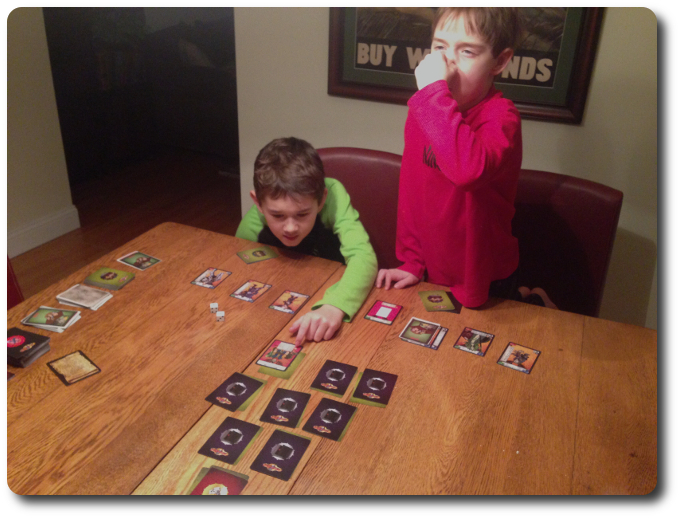
A stinky cloud of gas is revealed as the room’s challenge – stinky hilarity ensues
The Parent Geeks found Gauntlet of Heroes to be mindless fun. They found the game to be well suited for families, but didn’t enjoy the game at a peer level. According to one Parent Geek, “The game works great with my kids, but falls flat with other adults. It’s just draw cards, roll dice, and hope things go your way.” Another Parent Geek said, “I feel like I’m on a solo adventure that just so happens to have other players in the same dungeon as me.” Which is not to say that the Parent Geeks found this to be a bad thing. It just made Gauntlet of Heroes a game not well-suited for the Parent Geeks when the Child Geeks were either off to bed or playing in the other room. One Parent Geek did suggest that with the right group Gauntlet of Heroes would be excellent fun. As he put it, “If I was sitting down with my role-playing buddies, I think this game would do great.” Regardless of group or setting, all the Parent Geeks found equipping the Treasure cards to Hero cards to be the best part of the game, but didn’t care for the upkeep and maintenance required each time the Hero cards were rotated. Some grumbled, some sighed, but most just accepted it for what it was. All the Parent Geeks voted to approve the game for their families, finding Gauntlet of Heroes to be a fun time most of the time.
The Gamer Geeks were not that impressed with Gauntlet of Heroes. According to one Gamer Geek, “The only part of the game you have to think about is if you want to keep a Treasure card for points or use it to beef up your character, and it’s always an easy decision.” The Gamer Geeks liked the idea of equipping the Treasure cards, but were disappointed by how they were implemented. As one Gamer Geek put it, “This is a great example of a great idea that doesn’t work nearly as well in practice as it should.” Adjusting and readjusting equipped Treasure cards got real old real fast with the Gamer Geeks. All the Gamer Geeks did enjoy the ease of play and how players could offset luck by improving attributes. They found the humor of the game to be entertaining, the diversity of challenges to be intriguing, and the mix of heroes to be engaging. One Gamer Geek said, “The sheer number of cards in this game will always keep it different and fresh. I like that a lot.” When all the votes were in, the Gamer Geeks all agreed that Gauntlet of Heroes would be a great game for other players, but not for them.
The game’s most entertaining aspect is also its Achilles heel. Equipping the Treasure cards is surprisingly entertaining and rewarding. All of our players liked improving and altering their Hero cards in different ways, giving them bonuses and special abilities. The enthusiasm was dampened a great deal whenever the same Hero cards were rotated to indicate injury or healing. Depending on the playing surface, rotating 1 to 5 cards at one time was either slightly tricky or downright impossible. Too much time was spent realigning cards and not enough time focusing on the game at hand. This was noticed by all our players and was viewed as a negative.
Gauntlet of Heroes took me back to a simpler time when I would sit down with friends around the kitchen table to loot dungeons. There was no real story to follow, but there was a defined goal. Get into the dungeon, take all the treasure, and hack to pieces anything that got in our way. Gauntlet of Heroes comes across as an old school hack and slash dungeon crawl, complete with traps, trips, foils, and fun. The humor level is slightly above silly, which allows everyone to enjoy the game without taking it too seriously. Which is a very good thing, since Gauntlet of Heroes provides very little to think seriously about. For those looking for a good old-fashioned dungeon raid, Gauntlet of Heroes is sure to please. Its few flaws can be easily overlooked when your knee-deep in treasure.
This is a paid for review of the game’s final prototype. Although our time and focus was financially compensated, our words are our own. We’d need at least 10 million dollars before we started saying what other people wanted. Such is the statuesque and legendary integrity of Father Geek which cannot be bought except by those who own their own private islands and small countries.



